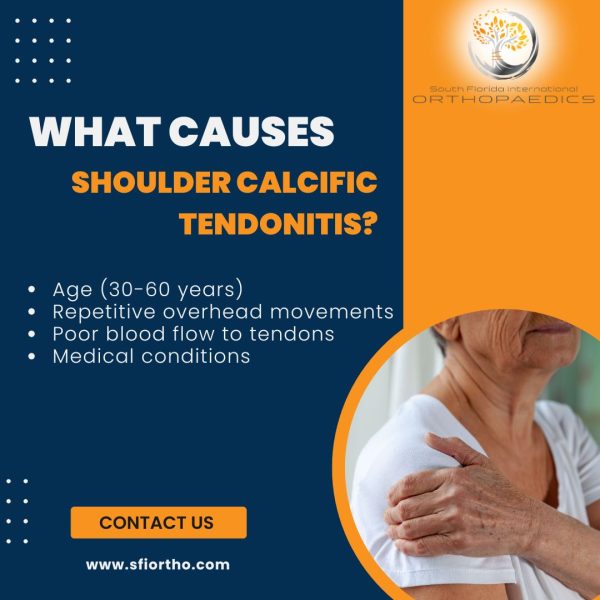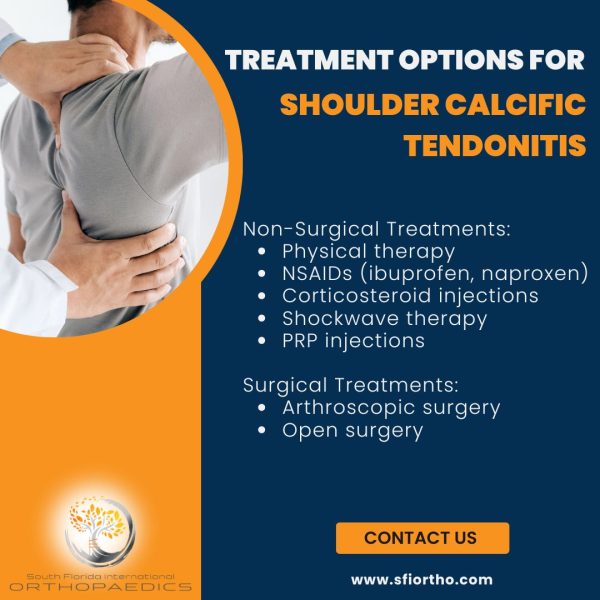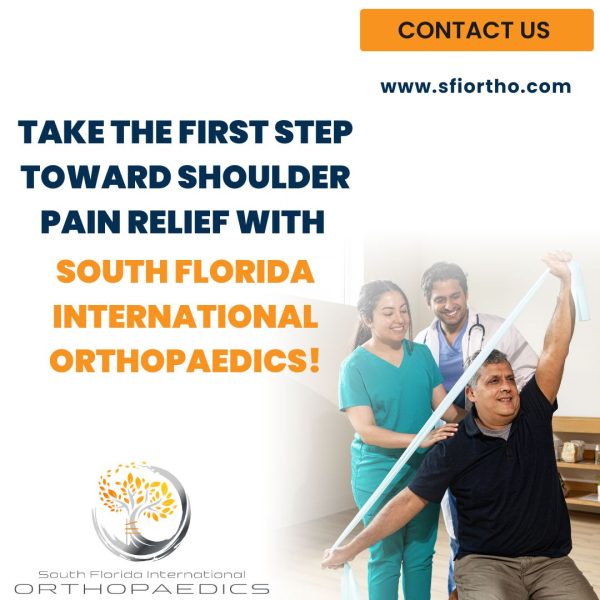Shoulder pain is a widespread issue, particularly among older adults globally, yet few may realize that one of the potential causes might be shoulder calcific tendonitis. It’s a condition characterized by the buildup of calcium deposits within the rotator cuff tendons.
The condition affects fewer than 10% of individuals seeking treatment for shoulder pain. However, when it does develop, it can cause severe pain, inflammation, and restricted movement, limiting the ability to perform everyday activities.
In this blog, we will explore the causes, symptoms, risk factors, and diagnostic process associated with calcific tendonitis. We will also dive into both non-surgical and surgical treatment options to help you understand how best to manage this painful condition and restore shoulder function.

What Causes Shoulder Calcific Tendonitis?
Calcific tendonitis occurs when calcium crystals accumulate in the rotator cuff tendons. The rotator cuff is responsible for stabilizing the shoulder joint and facilitating a wide range of arm movements. When calcium deposits form in these tendons, they cause irritation, inflammation, and pain.
Several factors can contribute to the development of calcific tendonitis:
Age:
People between the ages of 30 and 60 are most commonly affected by this condition. As we age, the tendons in the shoulder become more prone to degenerative changes, which increase the likelihood of calcium buildup.
Repetitive Movements:
Engaging in repetitive overhead motions, such as throwing, lifting, or swimming, puts extra strain on the shoulder tendons, potentially leading to calcium accumulation.
Poor Blood Flow:
Limited blood circulation to the shoulder tendons may prevent adequate healing, contributing to calcium deposits forming in the tendons.
Medical Conditions:
Certain metabolic conditions, like thyroid issues and diabetes, can affect calcium metabolism and increase the risk of developing calcific tendonitis.
Although the exact cause remains unclear, these factors can significantly increase your chances of developing this painful shoulder condition.
What Are the Symptoms of Shoulder Calcific Tendonitis?
Shoulder calcific tendonitis can present with a range of symptoms that can vary in severity. The most common signs include:
Pain During Movement:
People often experience shoulder pain with overhead activities like reaching, lifting, or throwing. The pain may be sharp and acute or more of an aching discomfort that worsens with movement.
Limited Range of Motion:
The presence of calcium deposits in the tendons can restrict the movement of the shoulder joint, leading to stiffness and difficulty lifting the arm or rotating the shoulder.
Swelling and Tenderness:
The affected area may become swollen and sensitive to touch. Swelling can occur as a result of the inflammation caused by the calcium buildup.
Pain at Night:
Many people with calcific tendonitis experience intensified pain at night, especially when lying on the affected side, which can make sleep uncomfortable.
If you’re dealing with these symptoms, seeking professional care from a shoulder specialist is crucial to determine the underlying cause and explore treatment options.
How Is Shoulder Calcific Tendonitis Diagnosed?
When you visit a doctor for suspected shoulder calcific tendonitis, they will start by performing a physical examination. This involves assessing your range of motion, checking for tenderness, and evaluating the shoulder joint for signs of inflammation. Imaging tests are necessary to confirm the diagnosis and understand the extent of calcium buildup.
X-rays:
X-ray imaging can identify calcium deposits in the tendons, offering clear evidence of the condition and allowing the physician to assess its severity.
Ultrasound:
This imaging technique provides a view of the soft tissues around the shoulder joint, making it particularly helpful for guiding certain treatments like injections or shockwave therapy.
MRI (Magnetic Resonance Imaging):
In certain cases, an MRI may be used to obtain detailed images of the rotator cuff tendons and assess any additional damage or inflammation that may be present.
An early diagnosis is vital in preventing the condition from worsening and improving the effectiveness of the treatment plan.

Treatment Options for Shoulder Calcific Tendonitis
The treatment approach for shoulder calcific tendonitis varies depending on the severity of the condition. Non-surgical treatments are typically the first line of defense. However, in some cases, surgical intervention may be necessary if conservative treatments fail to provide relief.
Non-Surgical Treatment Options
- Physical Therapy:
One of the first treatments recommended by a shoulder specialist is physical therapy. A physical therapist will guide you through exercises designed to strengthen the shoulder muscles, improve flexibility, and reduce pain. These exercises can help you restore full function to your shoulder and manage the inflammation caused by the calcium deposits.
- Non-Steroidal Anti-Inflammatory Drugs (NSAIDs):
Medications such as ibuprofen or naproxen can help reduce pain and inflammation associated with calcific tendonitis. These drugs are commonly used as part of the initial treatment plan to provide relief.
- Corticosteroid Injections:
If pain persists, corticosteroid injections may be used to reduce inflammation and provide temporary relief. These injections are often effective in the short term but should not be relied upon for long-term management.
- Shockwave Therapy:
Shockwave therapy is a non-invasive treatment option that uses high-energy sound waves to break up calcium deposits. This method can reduce pain and promote healing by stimulating blood flow to the affected tendons.
- Platelet-Rich Plasma (PRP) Injections:
PRP injections involve using the patient’s own blood, specifically the platelets, to promote healing and reduce inflammation in the affected tendons. This regenerative medicine approach has become an increasingly popular treatment for various musculoskeletal conditions, including shoulder calcific tendonitis.
Surgical Treatment Options
If conservative treatments are ineffective, surgical intervention may be necessary. Two common surgical options for treating shoulder calcific tendonitis include:
- Arthroscopic Surgery:
A minimally invasive surgery, arthroscopy involves small incisions through which a camera (arthroscope) is inserted to remove the calcium deposits or repair damaged tendons. This procedure generally offers faster recovery and fewer complications compared to traditional open surgery.
- Open Surgery:
In some cases, open surgery may be needed to remove larger calcium deposits or repair more extensive tendon damage. This surgery is less common but may be necessary for severe cases of calcific tendonitis.
Why Choose South Florida International Orthopaedics for Your Shoulder Care?
At South Florida International Orthopaedics we specialize in shoulder care and treatment. Whether you are experiencing symptoms of calcific tendonitis or need a comprehensive evaluation, our skilled shoulder specialists in Miami are ready to help.
We understand that each patient is unique, which is why we work closely with you to develop a treatment plan that best suits your specific needs and lifestyle. Our team of the best orthopedics in South Florida is committed to helping you regain full function of your shoulder and improve your quality of life through non-surgical treatments or, if necessary, advanced orthopedic surgery.
We also provide a range of treatments, including:
With a focus on regenerative medicine, we incorporate the latest techniques to accelerate healing and reduce pain, so you can get back to doing what you love.

Are You Ready to Take the First Step Toward Shoulder Pain Relief?
If you’re experiencing shoulder pain due to calcific tendonitis, don’t wait for the discomfort to worsen. Schedule an appointment today and start a pain-free life!
***
The material contained on this site is for informational purposes only and DOES NOT CONSTITUTE THE PROVIDING OF MEDICAL ADVICE, and is not intended to be a substitute for independent professional medical judgment, advice, diagnosis, or treatment. Always seek the advice of your physician or other qualified healthcare providers with any questions or concerns you may have regarding your health
